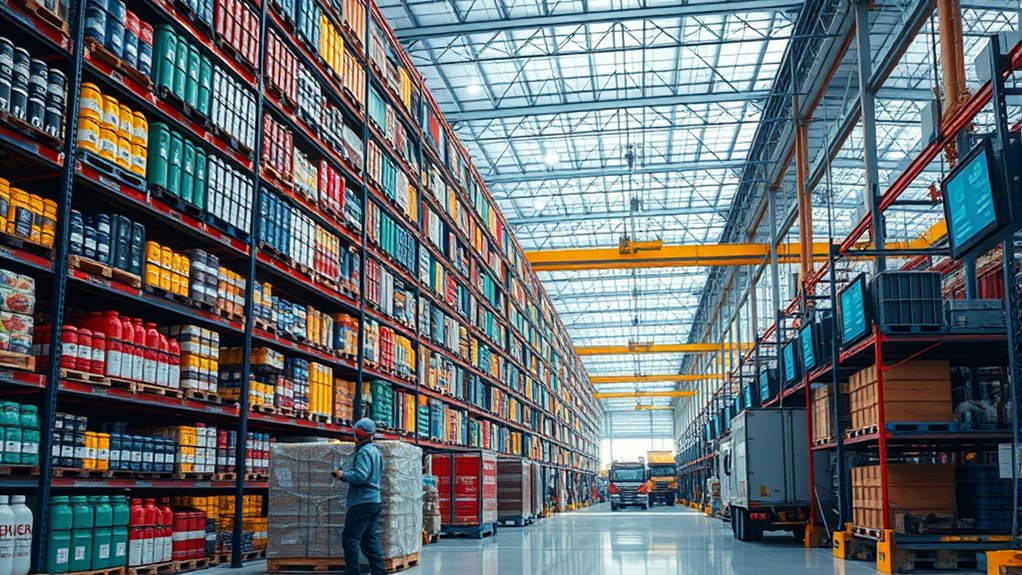By 2025, supply chain challenges in chemical raw materials will intensify due to geopolitical tensions, environmental regulations, and tech shifts. You’ll face disruptions and sourcing difficulties that threaten your operations. To stay resilient, it’s essential to adopt digital procurement tools that offer real-time data, diversify suppliers, and build transparent partnerships. Continuing this exploration will provide you with the strategies needed to navigate these upcoming risks and strengthen your supply chain resilience.
Key Takeaways
- Increasing geopolitical tensions and environmental regulations will heighten supply disruptions for chemical raw materials by 2025.
- Digital procurement strategies enable real-time risk assessment and rapid supplier diversification to mitigate supply chain vulnerabilities.
- Building resilient, adaptable supplier networks is essential to navigate ongoing economic fluctuations and geopolitical uncertainties.
- Continuous supply chain monitoring and early vulnerability detection will be critical for proactive risk management in 2025.
- Integration of digital tools with supplier resilience practices will enhance agility, responsiveness, and overall supply chain robustness.

The supply chain for chemical raw materials faces significant disruptions that can directly impact industries reliant on these essential components. As these materials become harder to source, your ability to adapt hinges on how well you leverage digital procurement strategies. Digital procurement streamlines your purchasing processes, offering real-time data and analytics that help you identify supply risks early. This technology enables you to quickly evaluate alternative suppliers, negotiate better terms, and reduce lead times. In an environment where supplier resilience is tested, relying solely on traditional methods can leave your operations vulnerable. Digital tools empower you to build a more resilient supply chain by providing better visibility into supplier performance, financial stability, and logistical vulnerabilities. This proactive approach allows you to anticipate disruptions rather than merely react to them, ensuring your production lines stay operational.
Supplier resilience remains a critical factor in steering ongoing and future challenges. You need suppliers who can withstand geopolitical tensions, economic fluctuations, and logistical hurdles. Strengthening supplier resilience involves diversifying your supplier base and fostering closer collaborations. Digital procurement platforms facilitate this by providing extensive data on potential partners, helping you assess their stability and capacity to deliver under pressure. When your suppliers are resilient, they can adapt more quickly to sudden disruptions, minimizing downtime for your business. Establishing strong relationships through transparent communication and shared risk management strategies further enhances resilience. You should also consider developing contingency plans with your key suppliers, ensuring you’re prepared for supply interruptions or quality issues. Additionally, investing in high-quality projectors for gaming enthusiasts can serve as an analogy for how technology enhances overall resilience by improving performance and adaptability.
Looking ahead to 2025, expect these challenges to intensify as geopolitical tensions, environmental regulations, and technological shifts continue to reshape the landscape. You’ll need to stay agile by embracing digital procurement tools that provide you with the agility to respond swiftly. Ensuring supplier resilience is equally crucial; it’s about creating a network of adaptable, trustworthy partners capable of weathering disruptions. Building robust digital systems will allow you to monitor supply chain health continuously, identify vulnerabilities early, and implement corrective actions in real-time. As disruptions become more frequent and complex, your success will depend on your ability to integrate digital procurement practices with a resilient supplier network. This approach not only safeguards your supply chain but also positions your business to thrive amid uncertainties in the chemical raw materials market.
Frequently Asked Questions
How Will Geopolitical Tensions Impact Chemical Raw Material Supplies?
Geopolitical tensions will likely disrupt your chemical raw material supplies through increased trade sanctions and strained diplomatic relations. These factors can lead to restricted exports, delays, and higher costs, making it harder for you to source essential materials reliably. You’ll need to stay adaptable, diversify suppliers, and monitor diplomatic developments closely to mitigate risks and keep your supply chain resilient amid ongoing geopolitical uncertainties.
What Technological Innovations Could Mitigate Future Supply Chain Disruptions?
You can mitigate future supply chain disruptions by adopting technological innovations like blockchain integration and AI demand forecasting. Blockchain enhances transparency and traceability, reducing delays and fraud, while AI predicts demand patterns more accurately, allowing you to adjust procurement proactively. These tools streamline operations, improve communication with suppliers, and help you respond swiftly to geopolitical or market shifts, ensuring a more resilient and efficient supply chain for chemical raw materials.
How Are Environmental Regulations Influencing Raw Material Sourcing Strategies?
Like Icarus flying too close to the sun, you might find environmental regulations pushing your sourcing strategies higher. These rules compel you to adopt sustainable sourcing practices and guarantee regulatory compliance, shaping where and how you acquire raw materials. You’re encouraged to explore eco-friendly suppliers and transparent supply chains, reducing risks of non-compliance and aligning your operations with eco-conscious standards, ultimately fostering a more resilient and responsible supply chain.
What Are the Predicted Cost Trends for Chemical Raw Materials Through 2025?
You can expect some cost fluctuation in chemical raw materials through 2025, driven by supply chain disruptions and fluctuating demand. However, overall pricing stability may improve as suppliers adapt and diversify sourcing strategies. While prices might spike temporarily during shortages, long-term trends suggest a balancing act, with costs stabilizing as markets adjust. Staying flexible and monitoring market signals will help you manage costs effectively.
How Can Companies Build Resilient Supply Chains Amid Global Uncertainties?
You can build resilient supply chains by embracing supplier diversification and inventory buffering, which often go hand in hand. When you diversify your suppliers, you reduce dependency on a single source, making your supply chain more adaptable during disruptions. Simultaneously, maintaining buffer inventories guarantees you can meet demand even when global uncertainties cause delays. These strategies, working together, help you stay flexible and prepared for unforeseen challenges.
Conclusion
As you navigate the evolving landscape of chemical raw materials, you’ll notice that supply chain challenges often seem coincidental—unexpected disruptions, global shifts, and technological leaps all intertwining. These coincidences remind you that staying adaptable is key. By anticipating these patterns and embracing innovation, you can turn unpredictable moments into opportunities. Ultimately, understanding these intertwined factors helps you build resilience and seize the chances that arise amidst the chaos, shaping a stronger, more flexible future.









